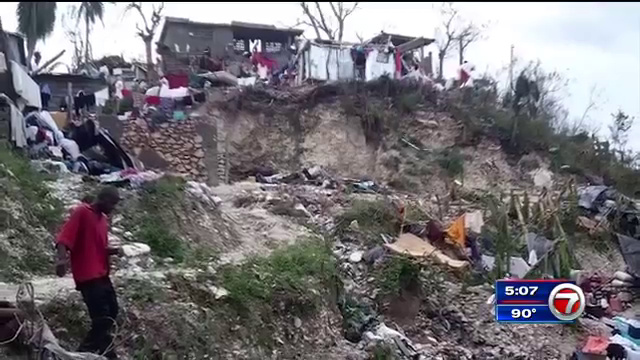JEREMIE, Haiti (AP) — As a pale blue coffin came into view, grieving women flung themselves to the floor near a morgue overlooking the ravaged city of Jeremie, where a humanitarian crisis has emerged in the wake of Hurricane Matthew.
Mourners beat their fists and screamed, their distress growing more intense as attendants opened the door of the morgue on Saturday to bring out the body of Roberto Laguerre, who was killed next to his 3-year-old daughter when the storm roared through this city in southwest Haiti as a Category 4 storm earlier in the week.
“Why did you leave us? Take me with you!” shouted relative Rita Honore.
Roberto and his daughter, Roseberlande, are among more than 500 people killed from the immediate effects of the storm in southwest Haiti. Authorities fear diseases such as cholera could cause more deaths in the area while the destruction of crops and livestock could cause many people to go hungry.
The precise death toll from the storm remained uncertain. Guillaume Silvera, a senior official with the Civil Protection Agency in the Grand-Anse Department, which is on the tip of the southern peninsula and includes the city of Jeremie, said they had confirmed 522 deaths, not including anyone in several remote communities that they have yet to reach because of collapsed roads and bridges.
“We think the numbers will have to go up,” Silvera said.
Civil Protection headquarters in Port-au-Prince, meanwhile, said Saturday their official count for the whole country was 336, which included 191 deaths in Grand-Anse.
UNICEF said that in Grand Anse alone there were 66,000 houses destroyed and 20,000 heavily damaged.
“Information gathered from various sources in the field suggest that the human toll (dead and injured) will be heavier than the current official figures,” the agency said in a report.
Death tolls are frequently difficult to tabulate in the immediate aftermath of a natural disaster in any country, though it is particularly difficult in remote and mountainous southwest Haiti.
Government officials estimate that at least 350,000 people need assistance, and concern was growing over an increase in cholera cases following widespread flooding unleashed by Matthew. An ongoing cholera outbreak has already killed roughly 10,000 people and sickened more than 800,000 since 2010, when the infectious disease was introduced into the country’s biggest river from a U.N. base where Nepalese peacekeepers were deployed.
Maria Sofia Sanon, a health worker overseeing the open-air cholera treatment center in a corner of Jeremie’s main hospital, said they were ill-equipped to deal with patients. The area was strewn with broken tree branches, and a group of young mothers sat outside holding up the arms of their glassy-eyed children being rehydrated via IVs.
“They’re not supposed to be in the sun, but we have no more beds,” Sanon said.
Nearby, officials with the Red Cross were unloading blankets, soaps, bleach and other items as aid began to reach remote corners of Haiti’s southwest peninsula.
“It’s beginning to pick up now,” said Stephane Rolland, coordinator for the International Federation of the Red Cross for Cuba, Haiti and the Dominican Republic.
Cuban medical teams were dispatched to coastal villages, and officials began distributing food in storm shelters and in the main plaza of Jeremie, where thousands of homes were damaged or destroyed and many people were running low on food.
Jocelyne Saint Preux was part of the crowd that lined up in an orderly fashion to get food as aid began to arrive, including shipments of food and other emergency supplies from the U.S. Agency for International Development carried by waves of military transport helicopters.
The mother of three children whose home was destroyed said officials were handing out wheat, beans, oil and salt.
“Yes, they brought food, but it’s not sufficient,” she said. “There’s no water. There’s no charcoal.”
As aid trickled into Jeremie, Jislene Jean-Baptiste surveyed what remained of the one-room house that the grandmother shares with her three daughters and their children. There wasn’t much left. Storm surge flowed across the road and drenched her belongings in waist-deep salt water, washing away the stores of rice and sugar she regularly sold at the market to support her family. Then the wind tore off her roof.
“That storm was the most terrifying thing that ever happened here,” she said.
Copyright 2024 The Associated Press. All rights reserved. This material may not be published, broadcast, rewritten or redistributed.

